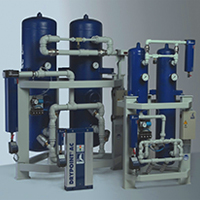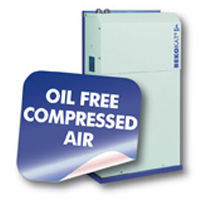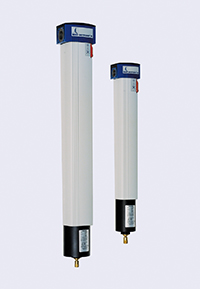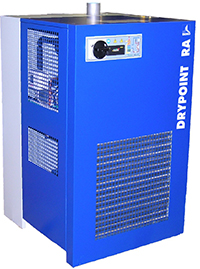 Surely it’s easy there are fridge dryers for 3°C Pressure Dew Point and desiccants for anything below that? In principle “Yes” says Chris Norris UK Service Manager for BEKO TECHNOLOGIES. “There are umpteen different ways to take it further than this simple rule. The client should ask himself several questions such as:-
Surely it’s easy there are fridge dryers for 3°C Pressure Dew Point and desiccants for anything below that? In principle “Yes” says Chris Norris UK Service Manager for BEKO TECHNOLOGIES. “There are umpteen different ways to take it further than this simple rule. The client should ask himself several questions such as:-
- What will be the lowest temperature in the system?
- Does the equipment requiring dry compressed air have a specification for dewpoint?
- What will be the flow and the variations?
- Is power available?
- What is the budget?
- Does the budget include for installation
- Will the addition of this piece of equipment and possibly filters mean raising the pressure because of inevitable pressure loss through a system
- Will my compressor go to this higher pressure
Just a few examples but as a manufacturer and supplier of all types of compressed air dryer, BEKO TECHNOLOGIES are in a unique position to give clients solutions not just sell them products. Let’s take a look at some of the ways compressed air can be dried, try to see where they fit and even look at the advantages and disadvantages of each type.
Membrane Dryers: This family of dryers is the simplest way to dry compressed air. They work on a very simple principle using a membrane that will allow one size of particle through whilst preventing others from passing. In this way different molecule sizes can be selected and membranes matched to do the relevant task. There is no power required for a membrane dryer and the dewpoint is typically 20°C below the temperature of the incoming compressed air. There is a built in filter to protect the membrane, which is sensitive to liquid water. The applications are typically for use on an OEM machine requiring clean dry air with a minimal space envelope but this product is underused and is a perfect point of use dryer which could for example take 3°C dew point air down to -17°C and avoid the purchase of a desiccant dryer. The disadvantage of this type of drying system is the purge loss which is around 10% and hence limits the genre to low flow less than 100 cfm applications where convenience outweighs the loss of compressed air.
R efrigeration or Fridge Dryers: These dryers are based on the fact that when air cools it will become saturated with water vapour and if further cooling takes place water will condense out. This together with the fact that air leaving compressors is 100% RH i.e. it cannot hold any more water and any cooling will cause condensation, totally unwelcome in the air network and should be controlled in the drying system. The family of fridge dryers has a range of from about 15 cfm to 5000 cfm and is also normally available air or water cooled. Higher pressure variants up to 50 bar are also available. The advantages of this type are that they are simple and robust and as such are a relatively small investment. The disadvantages are that to work on the gas circuit requires an engineer with an Fgas certificate. The dew point is limited by the fact that water freezes at 0°C and would block the dryer so +3°C is the lowest practical option. There are fridge dryers available with variable speed motors to reduce power but the key power reducing factor is the pressure drop through the product and the discerning buyer should base his decisions on reaching a reliable steady dew point with the minimum pressure loss through the system. Fridge dryers split into 2 families, thermal mass and direct expansion. Norris again “My criteria would be ease of maintenance, dew point stability and power usage. The thermal mass type attempts a small gain in power consumption but sacrifices dew point stability.
efrigeration or Fridge Dryers: These dryers are based on the fact that when air cools it will become saturated with water vapour and if further cooling takes place water will condense out. This together with the fact that air leaving compressors is 100% RH i.e. it cannot hold any more water and any cooling will cause condensation, totally unwelcome in the air network and should be controlled in the drying system. The family of fridge dryers has a range of from about 15 cfm to 5000 cfm and is also normally available air or water cooled. Higher pressure variants up to 50 bar are also available. The advantages of this type are that they are simple and robust and as such are a relatively small investment. The disadvantages are that to work on the gas circuit requires an engineer with an Fgas certificate. The dew point is limited by the fact that water freezes at 0°C and would block the dryer so +3°C is the lowest practical option. There are fridge dryers available with variable speed motors to reduce power but the key power reducing factor is the pressure drop through the product and the discerning buyer should base his decisions on reaching a reliable steady dew point with the minimum pressure loss through the system. Fridge dryers split into 2 families, thermal mass and direct expansion. Norris again “My criteria would be ease of maintenance, dew point stability and power usage. The thermal mass type attempts a small gain in power consumption but sacrifices dew point stability.
It will come down to client choice but if I were buying a dryer I would want a stable dew point and Direct Expansion is better in this area”
 Desiccant Dryers. Many industrial processes require a lower dew point than refrigeration can give. This could be for process reasons, hygroscopic materials in contact with compressed air, pneumatic conveying, instrumentation normally requires a minimum of -20°C pressure dew point. Other reasons could simply be that much of the process is outdoors and sensibly needs a better dew point than the lowest possible ambient temperature.
Desiccant Dryers. Many industrial processes require a lower dew point than refrigeration can give. This could be for process reasons, hygroscopic materials in contact with compressed air, pneumatic conveying, instrumentation normally requires a minimum of -20°C pressure dew point. Other reasons could simply be that much of the process is outdoors and sensibly needs a better dew point than the lowest possible ambient temperature.
 This family of products has the biggest diversity and hence complexity. They all rely on a material, the “desiccant” which will attract water vapour onto its molecular structure without chemical change and can be regenerated for repeated use. The range of the product is from very small <10cfm to as big as you like tailor built products. There are many variations such as modular dryers which are designed to go through industrial doors and can be “stacked” to increase flow capability going through to precisely engineered products for tough specifications such as the high humidity and temperatures of SE Asia or simply a limiting parameter such as roof clearance, where BEKO TECHNOLOGIES for example would design the vessels in accordance with the needs.
This family of products has the biggest diversity and hence complexity. They all rely on a material, the “desiccant” which will attract water vapour onto its molecular structure without chemical change and can be regenerated for repeated use. The range of the product is from very small <10cfm to as big as you like tailor built products. There are many variations such as modular dryers which are designed to go through industrial doors and can be “stacked” to increase flow capability going through to precisely engineered products for tough specifications such as the high humidity and temperatures of SE Asia or simply a limiting parameter such as roof clearance, where BEKO TECHNOLOGIES for example would design the vessels in accordance with the needs.
The key advantages of this product family are scope of the range, very low dew points to -70°C, zero purge products where no compressed air is lost and very good dew point stability. The downsides could be that they are more expensive, require more space and the maintenance although not difficult usually is done by the manufacturer or distributor.
There is a “Beware Buyer” here because there are a lot of products and the sales of large process dryers are not very frequent in the UK in the 21st century. There are a number of “heatless dryers” still in use or offered which can consume close to 20% of the compressed air in the regeneration of the desiccant. Guess what? they were very cheap to buy but do the maths and find out the horror of the running costs. There are also some zero purge or heat of compression dryers that do not reach the same dew point under all conditions but like membrane dryers work on a suppression principle which is typically 40°C therefore inlet compressed air at 30°C (40% of the year) will give a -10°C dew point.
Final word from Chris Norris who has 25 years’ experience on compressed air dryers “It can be a minefield for customers trying to sort out how to go about filtering, drying and maybe measuring compressed air but at BEKO TECHNOLOGIES there is a minimum of 10 years’ experience of all our field staff which together with the fact that we have all the products means that we will get to the best solution!”
Company: BEKO Technologies Limited, 2 & 3 West Court, Buntsford Park Road, Bromsgrove, Worcestershire, England, B60 3DX.
Tel: 01527 575778. Fax: 01527 575779. Contact: Ruth Goodison
E-mail: This email address is being protected from spambots. You need JavaScript enabled to view it. Website: www.beko-technologies.co.uk

